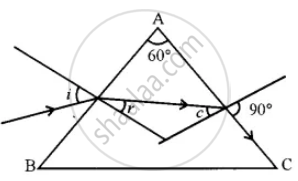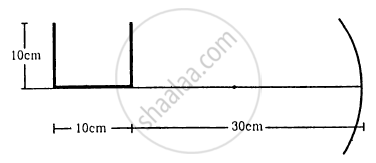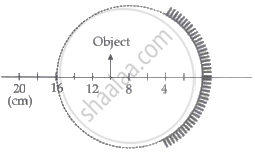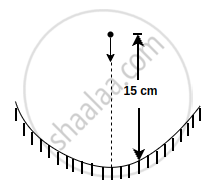Advertisements
Advertisements
प्रश्न
State how the focal length of a glass lens (Refractive Index 1.5) changes when it is completely immersed in:
(i) Water (Refractive Index 1.33)
(ii) A liquid (Refractive Index 1.65)
उत्तर
We know
`1/"f" = (mu - 1) (1/"R"_1 - 1/"R"_2)`

When the lens is submerged into water of R.I. = 1.33, then `1/"f" = (mu_12 - 1) (1/"R"_1 - 1/"R"_2)`
`("f"')/"f" = (mu -1)/(mu_12 - 1) = ((1.56 - 1)/(1.56/1.33 -1))`
`therefore ("f"')/"f" = ((0.56) xx 1.33)/(1.56 - 1.33) = 3.24`
Thus, focal length of the lens increases.
Similarly, for another liquid
`("f"')/"f" = ((1.56 - 1)/(1.56/1.65 - 1)) = - (0.56 xx 1.65)/0.09 = - 9.7`
i.e. the convex lens behaves as a concave lens.
APPEARS IN
संबंधित प्रश्न
If an object far away from a convex mirror moves towards the mirror, the image also moves. Does it move faster, slower or at the same speed as compared to the object?
A U-shaped wire is placed before a concave mirror having radius of curvature 20 cm as shown in figure. Find the total length of the image.

A converging lens of focal length 12 cm and a diverging mirror of focal length 7.5 cm are placed 5.0 cm apart with their principal axes coinciding. Where should an object be placed so that its image falls on itself?
A converging lens of focal length 40 cm is kept in contact with a diverging lens of focal length 30 cm. Find the focal length of the combination .
Answer the following question.
With the help of a ray diagram, obtain the relation between its focal length and radius of curvature.
Focal length of a mirror is given by ______.
You are given four sources of light each one providing a light of a single colour – red, blue, green and yellow. Suppose the angle of refraction for a beam of yellow light corresponding to a particular angle of incidence at the interface of two media is 90°. Which of the following statements is correct if the source of yellow light is replaced with that of other lights without changing the angle of incidence?
A spherical mirror is obtained as shown in the figure from a hollow glass sphere. if an object is positioned in front of the mirror, what will be the nature and magnification of the image of the object? (Figure drawn as schematic and not to scale)

A particle is dropped along the axis from a height 15 cm on a concave mirror of focal length 30 cm as shown in figure. The acceleration due to gravity is 10 m/s2. Find the maximum speed of image in m/s:

A converging lens has a focal length of 10 cm in air. It is made of a material with a refractive index of 1.6. If it is immersed in a liquid of refractive index 1.3, find its new focal length.
